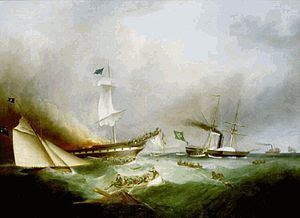Name Ocean Monarch Type Barque Length 55 m | Operator White Diamond Line Launched July 1847 | |
 | ||
Fate Caught fire and sank, 24/25 August 1848 | ||
Ocean Monarch was an emigration barque which in 1848 caught fire at sea and sank with the loss of 178 lives. The barque was owned by the White Diamond Line and was registered in Boston, the port where she was built. The Ocean Monarch was launched from the East Boston shipyard of Donald McKay in July 1847.
Contents
Burning of the Ocean Monarch
Ocean Monarch had left Liverpool on the morning of Thursday, 24 August 1848 carrying passengers to Boston in the United States of America. Helmed by a Captain Murdoch, the Ocean Monarch was towed from the port and entered the open sea around eight o'clock in the morning. Not far from harbour, between Abergele Bay and Great Orme's Head off Llandudno, at around noon, the Ocean Monarch was witnessed to put up its helm as if to return to port and then a flag of distress was raised. Within a short time flames were seen rising towards the rear of the vessel.
In an attempt to control the fire, which was now a blaze, Captain Murdoch attempted to turn the ship up wind, but in failing to do so, dropped both anchors. At this time it was apparent that the crew had lost control of the passengers who had begun fleeing the fire, rushing around deck in panic and even throwing themselves overboard. The captain ordered all moveable spars overboard to give those passengers in the water an aid in flotation.
Two other vessels in the area, came immediately to the ships aid, they were the yacht Queen of the Ocean, captained by Mr. Thomas Littledale; and the Brazilian frigate Affonso, captained by J.M. Lisboa. On board the Affonso was Admiral John Pascoe Grenfell who was superintending the trial of the frigate, he would later man a boat as part of the rescue. Later on two other vessels would join, what quickly became a sea rescue, they were an American packet New World and the railway steamer Prince of Wales. These rescuing vessels launched boats to aid the collection of the survivors. The Affonso managed to get close enough to the Ocean Monarch to fasten a rope to her allowing for rapid ferrying of passengers via boats.
By three o'clock the last ship at the scene, Queen of the Ocean turned and headed for Liverpool with their cargo of survivors.
On Friday, 25 August 1848 the Ocean Monarch went down at her anchored point to a depth of roughly 14 fathoms (25 m). Her location is listed at 53°25′40.00″N 3°35′27.00″W.
The Burning of the Ocean Monarch off the Great Orme is a series of three paintings by British artist Samuel Walters (1811-1882).
Cause of the fire
It was initially reported in the Liverpool Mercury that the fire came from a wooden ventilator, which a passenger had mistaken for a chimney. This was later refuted by Captain Murdoch, stating that the craft had iron ventilators, and he believed that smoking amongst the steerage passengers, from whom he had confiscated smoking pipes earlier, was the cause.
Frederick Jerome
Frederick Jerome a sailor working aboard the New World, born in Portsmouth, but then a resident of New York, showed personal bravery during the rescue. He dived into the sea, swam to the burning ship and lifted more than fifteen female passengers into a rescuing boat. On his return to New York he was awarded the freedom of the city by the Common Council of New York. He also received a £50 award from Queen Victoria and another £50 from the Prince de Joinville and the Duc d'Aumale, both aboard the Affonso.
Survivor statistics
1 The figures given for the event are mathematically incorrect, but are recorded as given by the newspapers of the time.
